#rip george romero
Text

Now showing on DuranDuranTulsa's Horror Show...Day Of The Dead (1985) on glorious vintage Media Home Entertainment VHS 📼! #movie #movies #horror #dayofthedead #nightofthelivingdead #georgeromero #ripgeorgeromero #Zombies #loricardille #JosephPilato #ripjosephpilato #anthonydileojr #tomsavini #TerryAlexander #GaryHowardKlar #ripgaryhowardklar #GregNicotero #shermanhoward #richardliberty #riprichardliberty #JarlathConroy #ralphmarrero #vintage #vhs #mediahomeentertainment #80s #durandurantulsa #durandurantulsashorrorshow
#movies#movie#horror#day of the dead#night of the living dead#george romero#rip george romero#zombies#Lori Cardille#Joseph Pilato#rip joseph pilato#Anthony Dileo Jr#tom savini#Gary Howard Klar#rip gary howard klar#terry alexander#greg nicotero#Sherman Howard#Richard Liberty#rip richard liberty#jarlath conroy#Ralph Marrero#vintage#VHS#media home entertainment#80s#duran duran tulsa's horror show#duran duran tulsa#Spotify
9 notes
·
View notes
Text
Midnight Pals: Gay Space Communism
Aubrey Wood: Submitted for the approval of the Midnight Society, I call this the tale of the cyberpunk future
Wood: [flashlight under chin] of luxury gay space communism!
King: uh
King: we mostly tell horror stories here
Dan Simmons: [clutching pearls] gay space communism!?
Aubrey Wood: this is a cyberpunk future where everyone has pink hair
Simmons: no! no! Stop!!!
Simmons: this is the future greta Thunberg wants!!!
George Romero: yeah! Yeah! Gay space communism!!!
Romero: hell yeah!!!
Wood: in the cyberpunk future, there’s lots of queer people and transhumanist technology mods
Simmons: NO! the two things I hate the most!
Simmons: what a world
Simmons: what a world
Wood: in the cyberpunk future, gutterpunks be using body mods to fight the system
Wood: like those cybernetic eye sphincter things
Romero: yeah! yeah! I want one of those
Wood: sorry you gotta be trans to have a cybernetic eye sphincter thing
Wood: I don’t make the rules, pal
Wood: the future is now, old man!!
Romero: aw but i wanted a cybernetic eye sphincter thing
Wood: sorry old man
Wood: but we could outfit you with, like, a cool old man duster
Romero: yeah. Yeah!
King: hey everyone i
King: uh
King: what’s going on here
Wood: I just threepwooded George romero
Romero: back off, fash, we’re gay space communists now
Wood: hell yeah, the old man is catching on
Wood: watch, I’m gonna show him how to do massive bong rips
#midnight pals#the midnight society#midnight society#stephen king#dan simmons#george romero#aubrey wood
91 notes
·
View notes
Text
Book Review: The Living Dead (Daniel Kraus, George A. Romero)

Been wanting to read this for a good long while (Well, 2019 I guess). First, I had to wait for the standard annual wait between hardback and the more desirable/affordable paperback, then I had to wait for that to be a bit more affordable too. And, well...I also had to muster up the determination to actually read the damn thing, because this book is huge, and whilst not the biggest book out there by any means, it’s very easily the largest one I’ve read since I rekindled my love of books during the Covid lockdown in 2020.
And it is big for a reason, this is a true epic of a zombie novel, one that spans over a decade and follows a huge assortment of different characters in a wide array of different locations/circumstances. Across nearly 800 pages (In the paperback at least), this is the late, great George A. Romero’s definitive and final word on the ‘Dead’ series he created back in 1968. One that covers pretty much everything you could hope to cover on the subject, and it does so with his well known understanding that largely it’s less about the zombies and more about the blood-soaked mirror they hold up to the real world and the way humanity behaves within it. But still ripping guts out and all that fun stuff. The best of both worlds, I say!
Now, obviously Romero himself didn’t write the novel, or at least he didn’t manage to finish it. Daniel Kraus was brought in to write it after the legendary director’s passing in 2017, using unfinished writing, notes and plans, and various loosely connected short stories by Romero to bring this final piece of work to life. Now sadly, and despite a chunky authors note at the end which is well worth the read, I remain unclear on how much of this was actually Romero’s work and how much has been improvised by Kraus, but all the same it ended up a mostly quite excellent read.
‘The Living Dead’ is broken up into three acts. More-so it’s broken up into two acts with a short bit of connective tissue between to bridge the large gap of years between start and end.
The first act is set broadly in the first couple weeks of the ‘Dawn’, charting what could well be the first instance of someone coming back from the dead, and then exploring, through a wide array of perspectives and locations, how humanity responds to the end of the world as we know it. Amongst our collection of protagonists are a pair of pathologists, a woman living in a trailer park, a TV journalist and a Naval officer stationed on a aircraft carrier. To name but a few. Needless to say all their differing locations, ages and perspectives lead to a multitude of different tones and scales. With the Naval element providing the kind of bombastic insanity that would’ve likely never made it to the big screen for budgetary/content reasons, whilst the pathologist thread is more intimate and sombre. The main things connecting all these stories, bar some loose shared elements, is both the viscerally described and brutal nature of the violence that ensues, and the way in which both modern American life, and the concept of death and undeath, are explored in both sociopolitical and philosophical contexts. There’s a lot of ‘evil phone bad’ kinda stuff that didn’t quite work for me, but beyond that it’s all quite engaging, and turns the novel into as much of a grim reflection on human nature, in all its highs and lows, in addition to faith and class/race division, as it is a blood and guts zombie epic. Which is exactly what Romero’s ‘Dead’ films were like at their absolute finest.
The second act, which I won’t spoil the grander details of, takes place over a decade after the dead rose, and sees several of the previously established characters ending up in the same location. In my opinion, this act is where the novel gets the most wild and interesting with its zombie elements. Again, it’s best left discovering yourself, but there’s certainly a lot more to all of this than just zombies munching on legs and limbs, and this more nuanced and elaborate take on the undead, again, feeds into the politically charged and ultimately pessimistic vibes of the overall story.
And it is a mostly quite grim read. If you aren’t into gore, even when written down on paper, this isn’t the book for you. If you’re looking for something that will raise your spirits or offer happy endings...you clearly haven’t watched Romero’s previous works in the genre, that much is certain. This is a bleak and brutal epic that questions humanities role on the Earth, and whether or not they can ever ultimately turn around the sinking ship that is modern civilisation into something better for both us, and the planet. There’s a lot of heavy, existential themes to contend with, so if you’re just looking for a bit of spooky fun, this ain’t gonna do it for you. Especially given its titanic length.
Personally, I found it all quite fascinating and gripping to read through. I was really worried before starting that this was going to be a slog...it’s a huge book, and if a huge book isn’t hooking you in, then you’re going to be stuck on it for a long time. Fortunately I enjoyed it a lot, and whilst some elements maybe overextend into goofy or extremely contrived territory, as a lot of Romero’s works ultimately did, even those were at the very least still striking and entertaining.
This is certainly a much better final word on the zombie phenomena Romero himself created back in the 60s, as opposed to the, frankly, abysmal ‘Survival of the Dead’ from 2010, which sadly constituted his final cinematic work. With Romero’s ideas and Daniel Kraus’ strong and poetic writing, this is a must-read for any fan of the genre, and indeed any fan of the ‘Dead’ series of films. Some of it may come across as a little familiar (Shades of ‘World War Z’ for instance), as a lot of zombie material does these days, but ultimately the scope and final destination of the epic journey make this one of the definitive works of zombie media. Flawed in parts, but still highly recommended.
Read it or Leave it : Read It.
Reading Next (The Lamplighters by Emma Stonex)
#Books#Novels#Review#George A. Romero#Romero#Dawn of the Dead#Dead of the Dead#Daniel Kraus#Horror#Zombies#The Stickman#Reading
5 notes
·
View notes
Text
She Comes Tonight fits in a very specific niche of pulp horror that I’m only now further understanding, having made films exactly like it myself. See, every so often the onward march of tech democratization catches up to the onward march of tech advancement. It’s happening again if you can’t tell. Did you know that GoPros shoot 4k? And they’ve been doing this for awhile?
Basically, throughout history we’ve hit points where cinema-grade production equipment gets cheap. Or at least cheap to rent. Something in the great supply chain in the sky twists just right and schlubby directors with a few grand can crank out projects within a few degrees of camera quality from big names in studios. It’s never AS good but it’ll play OK in theaters without looking like it was shot on a handicam.
Recently you’ll see this with cell phones getting better cameras (and some schlub will roll out a film “Shot on iPhone” where you can’t critique it for being bad because shooting on a phone is impressive for anyone) but that pattern tracks to cameras. This means we’re in another renaissance where young horror directors are putting their brains to work just like George Romero and putting out something much worse than George Romero.
She Comes Tonight is one of those films. In a way, it’s a return to grindhouse pulp of the past. In another, it’s a complete failure to return to what we need: gore-filled exploitation horror to balance out an A24 imitator-filled ecosystem.
Now my main point when I opine on these things was that Pulp films from the past look so good because at the end of the day, they’re shot on film and new digital films don’t have that. What makes the Blair Witch project nice is the handheld cam aspect of the whole deal. She Comes Tonight and movies like it simply don’t have that charm to save them, but they’re basically analogous. But I don’t think that this is what ruined the movie for me.
My next point was that the movie could feasibly have saved itself if it had lowered its scope some and focused on production value on the other side of the camera lens. I’ve seen tons of low/no budget flicks really pull off stories that would be way outside their price range through costumes, set decoration, and other little things that go a long way toward making them professional.
The thing is that both of these points don’t matter. I loved the first Evil Dead and it has neither of these, really. Not that the first Evil Dead is necessarily oscarbait but it has a charm to it, just like a multitude of lesser horror films that I have enjoyed despite lack of production value and a contextual knowledge preventing overt use of nostalgia glasses.
What killed She Comes Tonight for me was that even as a “Horror Comedy” the movie simply failed to understand that self aware horror stopped being fun around the time that the Scary Movie Franchise started to flag, and that even if you can pull off self aware horror in an oversaturated market, you don’t do it with MCU-level “he’s behind me, isn’t he?” dialog. The overt nudity in the film didn’t even come off as fun exploitation but rather more like an instagram skit video mimicking a porn opening where it’s just stilted and awkward.
The gore was fun though. And the soundtrack rips. The practical effects and synthy soundtrack had no business being that good for a movie with an orgasm joke in the title.
2 notes
·
View notes
Text
Blu-ray Review: The Living Dead at Manchester Morgue

You'd be hard-pressed to find anyone who would argue that Night of the Living Dead is anything less than one of the most influential horror movies of all time, but it wasn't until Romero followed it up with Dawn of the Dead a decade later that the floodgates opened to unleash imitators like a horde of the undead. Night of the Living Dead's success inspired other independent horror movies but only a scant few zombie outings.
Chief among them is director Jorge Grau's 1974 effort The Living Dead at Manchester Morgue, also known as Let Sleeping Corpses Lie (a rare instance in which the US rebranding is superior to the original title); a highly underrated zombie movie. The similarities to Night of the Living Dead are irrefutable (it was, in fact, pitched to Grau as “Night of the Living Dead in color”), but it avoids playing like a derivative rip-off. A Spanish-Italian co-production lensed in England, it harnesses an international flavor along with ample atmosphere.

After getting into an accident with one another while traveling in the England countryside, brash motorcyclist George Meaning (Ray Lovelock, Fiddler on the Roof) hitches a ride with Edna Simmonds (Cristina Galbó, What Have You Done to Solange?), a Londoner visiting her drug addict sister. They soon learn about an experimental agricultural machine that harnesses ultrasonic radiation to make insects attack each other. As it turns out, it has the same effect on the nervous systems of newborns and the recently deceased.
Although its setting is rural, The Living Dead at Manchester Morgue lacks the contained aspect of Night of the Living Dead. Instead, writers Sandro Continenza and Marcello Coscia add the threat of a dogmatic local police sergeant (Arthur Kennedy, Lawrence of Arabia) who pins George and Edna as the primary suspects when dead bodies start to pop up. The trio have a great rapport, with the five-time Oscar nominee Kennedy stealing every scene he's in.

The film's scope is fairly small and its pacing slow, particularly in the first half, but it sticks the landing with a killer final act. It concludes with a gut-punch ending akin to Night of the Living Dead's finale, but it's chased with an EC Comics-esque comeuppance. The zombies are quite unsettling, and Giannetto De Rossi's (Dune, High Tension, Zombie) gut-munching gore is plentiful for the time, earning it a spot among the notorious "video nasties" that were banned in the UK in the '80s. The film also adopts Romero's penchant for social commentary.
While most would classify The Living Dead at Manchester Morgue as a zombie movie without hesitation, it may give pause to those who argue the semantics of a film like 28 Days Later. It doesn't adhere to every "rule" established by Romero, instead making several idiosyncratic deviations from the formula. Manchester Morgue's undead aren't flesh eaters but rather cold-blooded killers. They can infect other corpses with the blood of the living, but they don't transmit it to people. They lumber like conventional zombies yet use weapons to attack their prey. The only way to stop them is to set them on fire, rather than destroying the brain.

The Living Dead at Manchester Morgue was newly restored in 4K from the original 35mm camera negative by Synapse Films for a limited edition Steelbook release in 2020. A standard Blu-ray version — sans DVD, soundtrack CD, booklet, and poster — is now available at a more affordable price. The picture is crisp, complete with the original opening and closing credit sequences, as well as a new 5.1 English stereo surround remix and the original English theatrical mono mix. Although it lacks the archival special features from Blue Underground's 2009 Blu-ray, it offers plenty of fresh ones. Nevertheless, the clarity of Synapse's transfer blows the previous edition out the water.
The disc carries two film historian audio commentary tracks, one with Troy Howarth and another with Nathaniel Thompson and Bruce Holecheck. Despite some overlapping information, both are worth listening for ample insight. Even better is Jorge Grau: Catalonia’s Cult Film King, a feature-length documentary on the director. Along with commentary from Grau, it features input from De Rossi, composer Giuliano Sorgini, and various academics. Manchester Morgue, being his most celebrated work, is a focal point, but the rest of his career is discussed as well. Extras are rounded out by an interview with De Rossi, a 2019 film festival Q&A with De Rossi, the theatrical trailer, two TV spots, and two radio spots.
The Living Dead at Manchester Morgue is available now on Blu-ray via Synapse Films.
#the living dead at manchester morgue#horror#70s horror#1970s horror#synapse films#let sleeping corpses lie#review#dvd#gift#article#night of the living dead#jorge grau#arthur kennedy#ray lovelock#george romero
8 notes
·
View notes
Text
Quebrar pogueando con Dillom - Post Mortem en el museo

Al mejor estilo Rocketpower, pero con el propio Dillom en lugar de Limp Biskit, el jueves la Sala del Museo dejó todo en el pogo de Post Mortem.
Por Ginny Lupin
Fotos Mel Taramasco
La entrada de la Sala del Museo la noche del jueves 12 de Mayo parecía el set de filmación de Night of the living dead, el clásico de terror de George Romero. Jóvenes con remeras blancas ensangrentadas, ordenados en una fila de fusión gótica urbana que da la vuelta la manzana. No es la primera vez que el local frente al puerto agota las entradas de uno de sus shows, pero sí una rara ocasión en que - incluso 20 minutos antes del horario pautado para la apertura de puertas - el público ansioso copaba las calles de la zona.
Pasadas las 20, en la vereda se escuchaba a chicos coreando temas del argentino YSY A, otros tantos sacando fotos que documentaran la previa al “velorio” más esperado del año. Adentro, los que iban pasando especulaban con el setlist sobre la música de fondo; aunque una hora después poco podría distinguirse entre los gritos de euforia y la voz nasal de esta generación: Dillom desembarcaba en Montevideo.

¿Quién dijo que el pogo era patrimonio exclusivo del rock? Ya hablamos de que Dillom es imposible de encasillar, pero aún así habita el enorme paraguas contemplado por la movida urbana, un género no puntualmente asociado a la “cultura de agite”. Sin embargo, la audiencia de Dillom no tiene nada que envidiarle a las bandas pesadas en lo que a saltos y mosh respecta.
“En Argentina yo y los Ramones en NYC” no es una barra aleatoria en su single Pelotuda; pocos artistas pueden causar el tipo de impacto que causa Dillom. Un pibe de 21 años que dice “manchen una remera de rojo” desencadenando unas mil personas que siguen el dresscode. Chicos y chicas saltando, en llanto, pre-adolescentes con sus hermanxs más grandes compartiendo la música.
Dillom es un fenómeno que le pertenece a una nueva generación, una generación que recién está ingresando al mundo de la música en vivo, en un país donde muchos recitales están restringidos a mayores de edad. Pibes y pibas que empezaron a escuchar música en pandemia cuando no pasaba casi nada de manera presencial. Jóvenes recién están saliendo y entienden estas instancias como una misa, el encuentro con lo que los mueve.
Ese es el clima en la Sala del Museo sobre las 21 horas, cuando se apagaron las luces y empezó el delirio.
La apertura estuvo a cargo del local Knak con la participación estelar de Davus. Los exponentes del género urbano de nuestro país no habían sido anunciados como parte de la fecha, por lo que su presentación fue una grata sorpresa para el público; que recibió con entusiasmo hits como RICKY y adelantos del EP de Knak Korta, recién salido del horno.
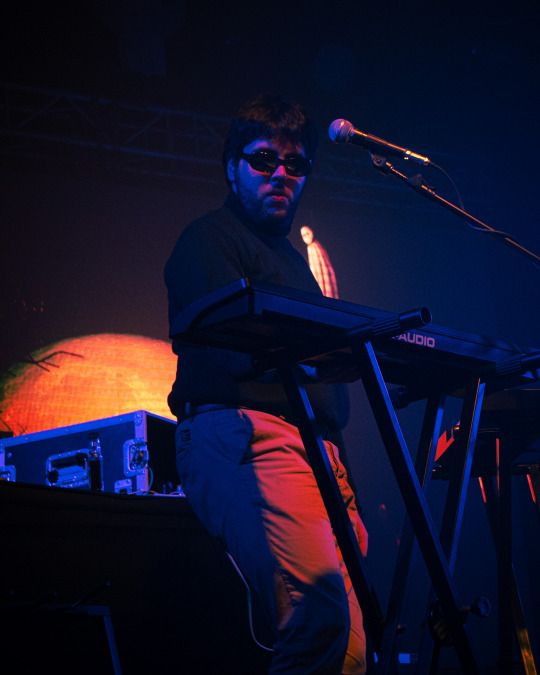
Luego del breve set de los uruguayos, llegó el turno del plato principal. Dillom se presentó segunda vez en Montevideo (la primera fue en 2019 en el marco del festival La Nueva Generación donde representó a la Rip Gang junto a su colega MuereJoven, también en el Museo del Carnaval). Esta vez, sin embargo, lo hizo acompañado de banda completa. ¡Y qué banda!
Fermin Ugarte, también productor de Post Mortem, hizo bailar a los asistentes rompiéndola en bajo, teclas y sintetizador. Gringo (quien reparte su tiempo entre la Post Mortem band y CXVERNXS, bruta banda metalera de la vecina orilla) dio gala de guitarra, agitando su pelo larguísimo al son de la música. que tambien fue productor de post mortem y la rompe en teclas, bajo y sinte. Gringo el violero que toca en CXVERNXS una bruta banda de metal y revolea sus pelos largos con trap tambien . Completaba el cuadro Haye en la batería fuerte, dinámica y precisa.

El set fue completísimo para el repertorio del artista, que repasó Post Mortem de pe a pa, intercalando el álbum con sus temas más clásicos.
El arranque fue con el track que da nombre al disco, precedido por Demian, el relato narrado por Mario Pergolini que también forma parte del álbum y fue un gran recurso para instalar el clima. Le siguieron Rili Rili, Piso 13 y Side - el costado más pesado de Dillom, quien se estiraba para tocar las manos del público desde el primer tema.
Con cambio de vestuario - ateniéndose él también al dresscode pautado de remera blanca manchada con “sangre” - se escuchó la pauta de Bohemian Groove, sello del artista; una suerte de brindis para la Rip Gang que si bien no acompañó el cruce del río, siempre está presente.
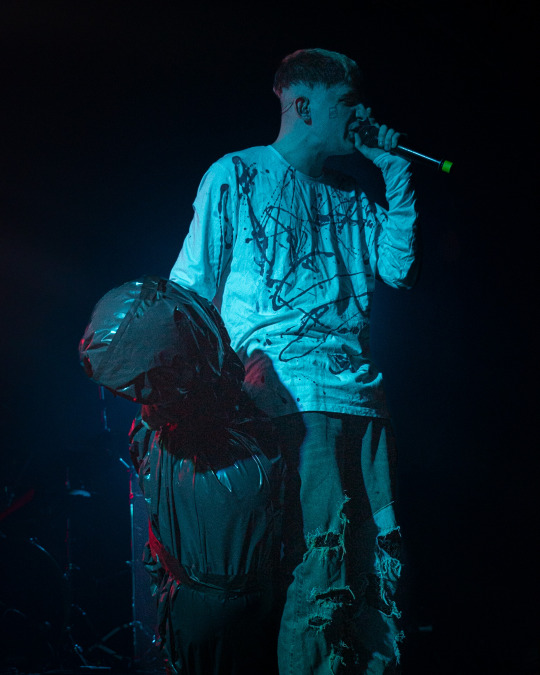
No faltaron las colaboraciones, aunque simbólicas ante la ausencia de sus compañeros: sonaron así por pista las voces de L-Gante en Hegemónica, Saramalacara en Rocketpower y Muerejoven en Coach.
También hubo cambio de vestuario - Dillom también sumado al dresscode de remera blanca manchada con “sangre” - y apareció la “utilería en forma de bolsas de consorcio simulando un cadáver desechado. No es la ambientación completa que ensombreció al teatro Vorterix e incluía un coche fúnebre estacionado en la puerta; pero es bastante considerando que acá nunca nos llega el combo completo de puesta en escena.

Dillom se tomó varios espacios para agradecer a sus seguidores por agotar la fecha, no sólo en palabras sino también gestos. Los fans más antiguos tuvieron su tiempo de brillar cuando sonaron A$AP y Casipegado, ambos del 2019, quizás ajenos para quienes se subieron a la Dillomneta tras el lanzamiento del disco.
También hubo espacio para lo emotivo cuando, precedido por un interludio con Toda la Gente, llegó el momento íntimo del show. Sauce, 220 y La Primera, quizás los temas más melódicos y “sensibles” de Dillom fueron cantadas con el micro en la jirafa y las voces del público más fuertes que la del artista.
Una pena el manejo del humo en este momento que de a ratos bloqueaba demasiado la vista; aunque el clima cercano se consiguió de todas maneras.
Sobre el final, Dudade y OPA explotaron como los hits que son, la gente saltando, ronda de pogo, empujones, abrazos y manos en el aire, como bendiciendo. A Dillom lo sigue un fanatismo febril que haría temblar a los Beatles; pero que es a la vez serio, solemne. Lo idolatran y le gritan, pero como a un referente, con un agradecimiento siempre implícito en su devoción. Un fenómeno tan único como quien lo genera, que fue curioso de presenciar el pasado jueves.

OPA podría haber sido el adiós, pero Dillom volvió con Amigos Nuevos, momentazo del disco y del recital que corona todo el mood Post Mortem, posicionando a Dillom como el artista completo que es. La despedida, que esperamos sea un hasta pronto, fue con Reality; y cumpliendo con la tradición (a pesar del nerviosismo de los encargados de seguridad) Dillom saltó a los brazos de su público. “Dejo el alma en el moshpit” canta Saramalacara en Rocketpower y así fue el jueves - el alma por la música, el sacrificio por su público.

#cobertura#crónica#reseña#ardeportal#dillom#post mortem#sala del museo#rip gang#montevideo#uruguay#ginny#mel taramasco
2 notes
·
View notes
Link
Check out this listing I just added to my Poshmark closet: ADIDAS 7 Mens ZOMBIE ATHLETIC GLOW IN THE DARK SHOES by DAMIAN LILLARD street.
0 notes
Text
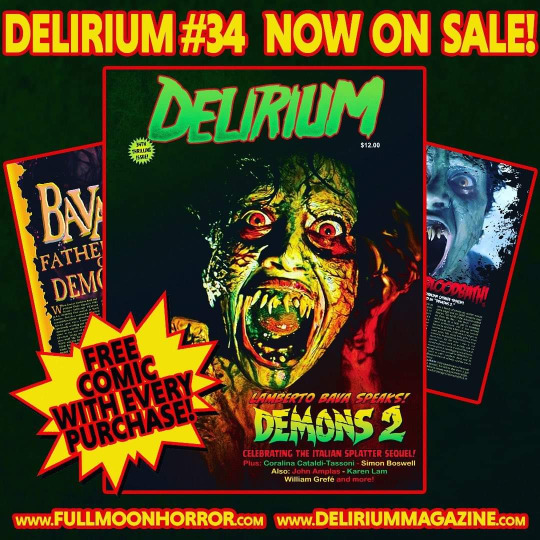
Delirium #34 Examines Demons 2
DELIRIUM #34 is here and ready to rip you to shreds!
This round, we celebrate director Lamberto Bava and producer Dario Argento’s gonzo 1986 gorefest DEMONS 2, the riotous follow-up to the duo’s landmark Italian horror masterpiece DEMONS! Inside, you’ll find EXCLUSIVE new interviews with Bava, star Coralina Cataldi-Tassoni and composer Simon Boswell as well as tons of freaky photos, a few of which you may have NEVER seen before.

Chasing our coverage of this creepy Eurohorror sequel, we have new chats with Florida-based auteur William Grefe about his eerie William Shatner shocker IMPULSE, words with actor John Amplas about the George Romero vampire classic MARTIN, one-on-one with Canadian filmmaker Karen Lam plus all manner of sexy, sanguinary awesomeness!
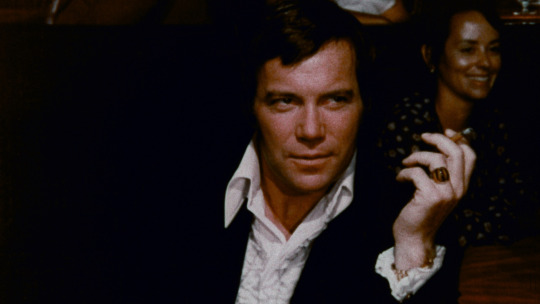
DELIRIUM is our slick, smart quarterly print magazine, prepped in limited batches for the hardcore horror collector. Subscribe to DELIRIUM (4 issues) now and start your journey into madness with THIS VERY ISSUE!
BUY THE NEW ISSUE HERE AND GET A FREE COMIC BOOK!
#Delirium Magazine#Charles Band#Full Moon Features#horror magazine#Fangoria#George Romero#William Grefe#John Amplas#Lamberto Bava#Coralina Cataldi-Tassoni
0 notes
Text
Karl Marx, Fascism, And The Living Dead
I got burned out on zombies several decades ago when serving as part of Joe Bob Briggs’ Board of Drive-In Experts (i.e., reviewers for his newsletter).
While I bear no animosity to the genre, I just saw one zombie flick too many and, like eating nothing but pistachio ice cream for a month, I got to the point where I didn’t want to face another one.
So I was a little surprised to have an extremely detailed zombie movie dream last night, not a nightmare, but rather a zombie movie playing out before me (i.e., I was a spectator of, not a participant in the dream).
It gave me an insight into the evolution of the zombie genre, and how the same reflects on us culturally.
So buckle up, buttercups, we’re going in for a deep dive…
. . .
First off, while I haven’t seen a new full length zombie movie or TV series since the last century, I have absorbed a lot of what’s going on in the sub-genre through sheer osmosis.
People write about these things all the time, the trailers are all over YouTube, images appear everywhere, Wikipedia supplies countless synopses, etc., etc., and of course, etc.
And while I wouldn’t count myself informed enough to comment on any specific new zombie film or TV show, I think I’ve been able to observe the sub-genre’s evolution pretty well as an outsider, not a fan.
Next to mad slasher movies, zombie films are the easiest horror movies to make: All you need are some old clothes and some garish make-up and voila, instant zombie.
That’s what burned me out, the seemingly endless non-variations on a theme by independent / semi-pro /amateur / total fnckin’ incompetent film makers that I needed to wade through.
I give many of them credit for ingenuity and the occasional oddball twist. One film maker staged a zombie invasion by putting six friends in make-up, driving to Washington DC in a van, hopping out in front of several landmarks, and quickly filming his buddies staggering around the Capitol, the Lincoln memorial, the Washington Monument, etc. before the cops chased them away.
Added a lot of production value to what otherwise looked like a $1.98 production.
But enough is enough,
know what I mean?
It’s important to note all these zombie flicks were inspired not so much directly by George Romero’s paradigm shifting approach to the sub-genre but indirectly after being filtered through the lens (literal and figurative) of various Italian rip-offs, many helmed by Lucio Fulci.
Fulci directed over 50 films in his career, all of them in some exploitation genre, but he hit his sweet spot with his gruesome-bordering-surrealistic zombie flicks, starting with Zombie 2, an official remake (i.e., plagiaristic rip-off) of George Romero’s Dawn Of The Dead (released in Italy as Zombie).
Fulci’s stylistic touches proved easier to emulate than Romero’s more thematic approach, but ironically this resulted in what’s called “bad truth” by many low budget film fans; i.e., a film that, because of speed and budget restraints, provides no filter to the film maker’s persona, and whatever results is a more honest glimpse into their mind and soul than a better made film with a bigger budget and longer shooting schedule.*
As a result, most zombie films became the very thing that Romero was commenting on.
. . .
Let’s start at the beginning: The true origin of the zombie mythos.
Zombies do exist, albeit not in the highly stylized form found in movies and pulp fiction.
As Wade Davis pointed out in his book, The Serpent & The Rainbow, Haitian shamans were known to produce a cocktail of near-toxic and mind-numbing substances that first reduced a victim to near-death physical status then, once revived, obliterated the ability for their mind to function at any but the most rudimentary level.
Needless to say, while the shamans could do this, they never did it on a scale approaching that in popular fiction, and actual cases of zombies are very few and very far between but it did happen, thus spawning the myth we have today.
Europeans learned of zombies in the early 19th century, but they really didn’t hit their stride until the 1930s when they began popping up in pulp fiction. The movie White Zombie (1932) is considered the first zombie movie (although revived corpses appeared earlier in other movies).
In addition to being a really good classic horror film, what makes White Zombie of particular importance is that it presents the original raison d’etre of the zombie mythos: Cheap enslaved labor.
While the zombie mythos drew on inspirations from around the world, Haiti remains the focal point, the time /place / culture that presented it full blown to the world.
Haiti became the first enslaved colony to free itself and declare independence in 1804; in 1819 the first reference to zombies appeared in an English language work.
Haitians, recently freed yet still crushed under a huge financial debt imposed on it by France, naturally embellished stories of zombies to include the victims being used to serve as virtually free unpaid labor for plantation owners.
As noted, while zombies do exist, they are far and few between. From a return-on-investment angle they are woefully labor-intensive to create with a high risk of failure.
The few documented cases of actual zombies suggests the motives may have been personal, with the victim’s enslavement just an additional degradation doled out on them.
White Zombie puts the concept on an industrial scale, with villain Murder Legendre (Bela Lugosi in one of his last good roles) using a battalion of enslaved zombies to operate his sugar cane plantation.
It’s a striking mundane yet simultaneously politically deep motive.
The late 19th and early 20th century saw a great conflict around the world at local and national levels between the proponents of socialism and / or communism and the forces of capital.
In particular, socialism (and to a lesser degree communism) gained a foothold in American culture following the Great Depression, and when White Zombie was made in 1932 the thought that corporations and business owners would willfully enslave and work their laborers to death was not the slightest bit removed from recent history, much less far fetched.
And while zombies in pulp fiction and comic books might have a variety of other origins, even there the financial angle typically proved the overriding motive for their creation.
For the next three decades, in films like King Of The Zombies (1941), its sequel Revenge Of The Zombies (1943), the Val Lewton classic I Walked With A Zombie (1943), Creature With The Atom Brain (1955), Invisible Invaders (1959), and Plague Of The Zombies (1966), this remained the central conceit in the way zombies were portrayed: Enslaved labor serving evil masters.**
George Romero overturned all that.
. . .
While zombies as enslaved labor remained the dominant paradigm of the sub-genre, there were alternate interpretations galore.
Some are zombie movies by default; i.e., the previously mentioned revived corpse movies where sometimes the victim was revived for altruistic purposes, sometimes for personal desire, sometimes just to have somebody handy to do all the heavy lifting.
Regardless of motive, this inevitably ended up badly for the resurrectionist.
While there had been a few movies like Zombies Of Mora Tau (1957) in which zombies operated independently as reanimated corpses, these were more in the lines of traditional ghost stories where the dead either protected or haunted a relic or holy site.
Romero shifted the classic zombie paradigm quite significantly not once, not twice, but three times.
The most frightening thing about the zombies in Romero’s Night Of The Living Dead (1968) is they are no longer under control.
As frightening as a cadre of shuffling living dead might be, they become even more terrifying when one realizes there’s absolutely no way to stop them short of their utter annihilation.
There is no evil witch doctor or mad scientist guiding their attack, there’s no off switch to be thrown.
Rather, Romero’s zombies are a force of (super)nature, absolutely unstoppable en masse.
They are incomprehensible because unlike the enslaved labor of earlier zombie films, there is no rational guiding motivation behind them.
I grant you “rational” is doing a lot of work here, but it’s not inappropriate. No matter how crazy the witch doctor or mad scientist may be, they’re motivated by a desire to fulfill their personal agenda, whatever it may be.
That their means and objective might both be utterly insane is beside the point, the zombies are merely the means to the end.
But as noted, Romero’s zombies in Night Of The Living Dead possess no meaning.
They exist simply to devour.
Romero expanded on this greatly with his sequel, Dawn Of The Dead (1978), this time hammering the point down hard: Zombies are the ultimate consumers.
They create nothing, they produce nothing, they do nothing, they simply destroy and eat those who do.
By setting Dawn Of The Dead in a fortified shopping mall besieged by zombies, Romero made a sharp cultural satire on modern consumer culture.
The Fulci inspired imitators who flooded screens with zombie movies after this didn’t merely miss Romero’s point, they did so by confirming his underlying thesis.
Without understanding, without actually creating anything new, they feasted on what others did before them.
And mind you, I’m not yucking anybody’s yum. Some of these imitators are interesting in their own right and I begrudge no one their pleasure.
But like all the imitators of Quentin Tarantino who fill their movies with oddball characters, quirky dialog, outrageous situations, and over the top violence, they imitate the style but not the substance.
With Dawn Of The Dead, Romero gave us something to chew on.***
And Romero’s third paradigm shift?
It wasn’t obvious at the time, and it’s taken a while to blossom, but he introduced that in Night Of The Living Dead as well: The bigots among us will quickly justify any reason to attack the other.
. . .
=SPOILER for those of you who haven’t seen the original Night Of The Living Dead yet.=
Ben (Duane Jones), the sole survivor of the besieged farmhouse, emerges only to be shot by a posse of good ol’ boys hunting zombies.
Ben is African-American, which in 1968’s political and cultural climate was pretty radical casting.
The good ol’ boys are seen earlier on a TV broadcast in Night Of The Living Dead, gleefully hunting down and destroying the zombies (called “ghouls” in Romero’s original version before he acquiesced to audiences’ preferred nomenclature). “When we find 'em, we can kill 'em…they're dead. They're all messed up,”
One may argue for several reasons that Ben’s death at the end of Night Of The Living Dead is intentional irony, that it’s the last tragic card laid down in a losing hand.
Indeed, had a white actor been cast as Ben (according to Romero, Jones won the role on the strength of his audition, not his ethnicity), the film’s ending would still play out.
But Ben as an African-American adds a whole new dimension to the climax suggesting he wasn’t killed in a tragic mistake but rather simply because to the good ol’ boys, he wasn’t a normal white guy like them but rather one of The Other.
So how does all this tie into my zombie movie dream?
In the dream movie, it’s shortly after the collapse of civilization in the aftermath of a zombie onslaught. The protagonists in the dream were looting various abandoned buildings, taking what they needed.
The zombies provided little direct threat. There was the sense if one got too close they could be trouble, but basically they weren’t as strong as humans, not as fast, and certainly not as intelligent.
While some of the protagonists simply sidestepped the zombies, others killed them even when the zombies posed no threat.
Those protagonists enjoyed hunting and killing zombies.
When I woke up, I realized the dream illuminated a third stage of evolution in cinematic zombies, as radical a change as Romero’s earlier ideas.
And I grant you, doubtlessly not an original insight on my part, but one I probably gleaned subconsciously from online exposure to clips from 28 Days Later (2002) and Resident Evil (2003) and Shaun Of The Dead (2004) and World War Z (2013) and the TV series The Walking Dead (2010 – 2022): As troublesome as zombies are, the real problem is us.
. . .
The evolution of screen zombies:
Labor unjustly enslaved by evil masters for sinister purposes. While scary, these zombies are no threat in and of themselves. It’s only when they’re directed to take action by their overlords that they become dangerous. In many ways they can be pitied.
Uncontrolled consumer culture. Essentially our neighbors and fellow citizens (indeed, the running joke in all zombie films are the vast array of different types of zombies -- farmers / doctors / cheerleaders / etc.). They consume without thinking, destroying every living thing they come in contact with, animated but not really alive. In short, the ultimate bourgeoisie.
The Other. Bigotry / authoritarianism / fascism needs an identifiable enemy to hate and destroy. There needs to be a monster to be slain in order to feel like a hero, but too often the slain are painted as monsters in order for the slayer to justify their own behavior.
“Beware that, when fighting monsters, you yourself do not become a monster... for when you gaze long into the abyss, the abyss gazes also into you.” -- Friedrich Nietzsche
© Buzz Dixon
* “Bad truth” also encompasses films made by directors who are such box office giants that no one dare say no to their slightest whims no matter how bad those ideas are (looking at you, George Lucas)
** The 1952 serial Zombies Of The Stratosphere featured no actual zombies; rather the term is used almost as an ethnic slur by the protagonists against the Martian invaders.
*** This one’s for you, Uncle Forry.
#movies#zombies#George Romero#Karl Marx#late stage capitalism#capitalism#socialism#communism#Lucio Fulci#Haiti#Friedrich Nietzsche
1 note
·
View note
Text
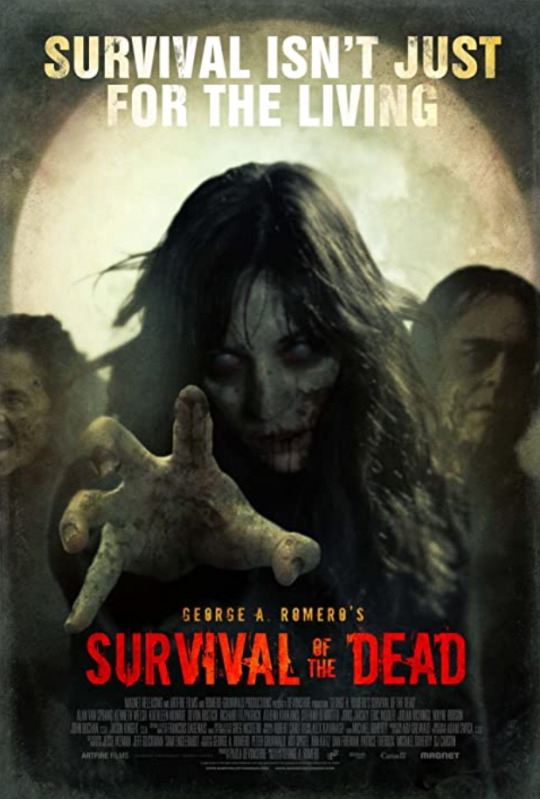
Survival of the Dead (2007) - Writer and Director: George A. Romero
"On an island off the coast of North America, local residents simultaneously fight a zombie epidemic while hoping for a cure to return their undead relatives back to their human state."
Again, like Diary, this isn't a bad zombie film. It has a completely different flow and again not one of Romero's best.
I don't really have too much to say about this film. I thought it was just "okay". Plenty of other zombie films out there that do the job better but hey, I've always been a fan of zombie films so I take what I can get.
Coupled with an unnecessary masturbation scene, and very obvious CGI heads on stakes, it shows how much of the $386,000 budget went into VFX for this film. That being said, it did make 4 million dollars at the box office, so I can't say it was a failure financially.
Kenneth Welsh (RIP) did a fantastic job in this film, holding up the acting and making everything funnier than it should have been. That's what I like in a horror film, at least a little bit of light comedy.
Much like Diary, I don't think this holds up as a great Romero film, but it shows how he went in a different direction compared to his earlier work. This movie just felt like a waste of 90 minutes to me. I didn't enjoy it as much as Diary even if it's a direct continuance.
The last 40+ minutes felt like a clusterfuck of random action and throwing in whatever they could to be "horrific" or "emotional". The first half of the film is just okay, but the remainder is boring and not even worth watching.
The story just stopped making sense. "What if we could teach the dead to eat something other than us?" What if you could have a good plot and ending, huh?
3/10
0 notes
Text
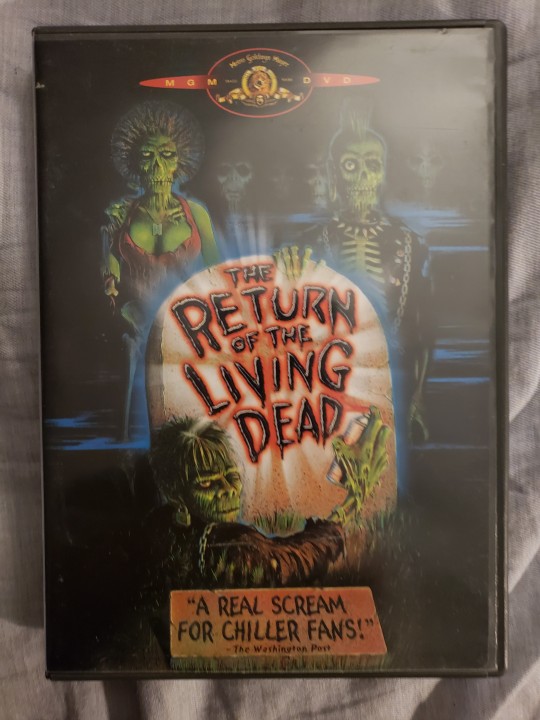
Now showing on DuranDuranTulsa's Horror Show...The Return Of The Living Dead (1985) on classic DVD 📀! #movie #movies #horror #returnofthelivingdead #nightofthelivingdead #georgeromero #ripgeorgeromero #Zombies #thommatthews #jameskaren #CluGulager #ripclugulager #doncalfa #linneaquigley #BeverlyRandolph #jewelshepard #johnphilpin #miguelanunezjr #markventurini #dvd #80s #durandurantulsa #durandurantulsashorrorshow
#movies#movie#horror#return of the living dead#night of the living dead#george romero#rip george romero#zombies#thom matthews#don salfa#beverly randolph#linnea quigley#clu gulager#rip clu gulager#james karen#jewel shepard#Miguel A Nunez Jr#john philbin#mark venturini#80s#dvd#duran duran tulsa's horror show#duran duran tulsa#Spotify
10 notes
·
View notes
Photo

It's been 5 years!? Rest in power, George! What's your favorite Romero film? Mine will always be Day of the Dead! #georgearomero #romero #nightofthelivingdead #dawnofthedead #dayofthedead #creepshow #horrormovies #zombies #ghouls #rip #restinpower #ink #sketch #sketchbook #digitalsketchbook #procreate #instaart #instaartist #instatoon #cartoonist #MatthewJamesArtist https://www.instagram.com/p/CgE7uiFLAWR/?igshid=NGJjMDIxMWI=
#georgearomero#romero#nightofthelivingdead#dawnofthedead#dayofthedead#creepshow#horrormovies#zombies#ghouls#rip#restinpower#ink#sketch#sketchbook#digitalsketchbook#procreate#instaart#instaartist#instatoon#cartoonist#matthewjamesartist
0 notes
Text
Horror Remakes Between 1999-2010: An Overview
Horror as a genre is contagious. People have always loved: blood, gore, zombies, and everything else that goes into the production and creation of horror movies. There are millions of fans around the world and it has been around for hundreds of years. People have been enjoying the scares since long before we were alive. Being so widely loved, horror films have continuously been remade for modern day screens. Why wouldn’t you want to watch something you love twice? This blog aims to look at various horror movies that have been remade between 1999 – 2010. I also plan to touch upon reasons why horror movies have been remade for modern day screens and the effect it has on the genre of horror.
THE RING, 2002:
The Ring, released in 2002 and directed by Gore Verbinski, is a remake of the 1998 Japanese horror film, Ring. Both films are based on the novel Ring, by Koji Suzuki who helped co-write both film versions. In the remake, Naomi Watts stars as Rachel as she deals with the psychological horrors the antagonist of the film, Samara wreaks havoc on her life. Samara was murdered by her mother and anyone who watches the video tape receives a phone call seven days before their horrific death. The remake did very well and was a success among fans. Check out the trailer for The Ring here: https://www.youtube.com/watch?v=yzR2GY-ew8I

DAWN OF THE DEAD, 2004:
Dawn of the Dead, released in 2004 and directed by Zack Snyder was a remake of George A. Romero’s 1978 film of the same name. Following the same storyline, a group of survivors take refuge in a shopping mall during a growing epidemic of flesh-eating zombies. A major difference between the two films is the zombies. The zombies in Dawn of the Dead, (1978), walk around aimlessly and are relatively slow. The characters were able to run through and dodge the zombies. In Dawn of the Dead, (2004), the zombies are aggressive and fast. The characters would be ripped to shreds if they tried to run through them. Another difference is the amount of chracters. Dawn of the Dead, 1978 focuses on three main characters, while Dawn of the Dead, 2004 focuses on 8 major characters along with various other survivors at the shopping mall. Fans tend to agree that the original Dawn of the Dead in 1978 wins. The zombies may be better in the 2004 version, but the original trumps the remake. Check out the trailer for Dawn of the Dead here: https://www.youtube.com/watch?v=DV8mJcuYVaA

HOUSE OF WAX, 2005:
House of Wax, released in 2005 and directed by Jaume Collet-Serraand is a remake of the 1953 film of the same name,, which is also a remake itself of the 1933 movie called Mystery of the Wax Museum. The 2005 remake grossed $70 million worldwide. The film follows a group of people who stumble into a ghost town with a strange wax museum as the biggest attraction. They must fight to survive as they are targeted to be the next exhibit. Check out the trailer for House of Wax here: https://www.youtube.com/watch?v=ezUtqfB24Cg

FUNNY GAMES, 2007:
Funny Games, released in 2007 and directed by Michael Haneke, is a remake of the1997 film of the same name. Both films follow a family captured and tortured by two juvenile criminals in their vacation home. The 2007 remake is a shot-for-shot remake and was successful among viewers. The family is brutally affected and suffer the consequences in both films. Check out the trailer for Funny Games here: https://www.youtube.com/watch?v=_3o49aoh8t8
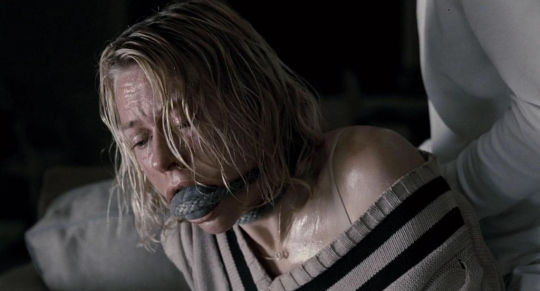
FRIDAY THE 13TH, 2009:
Friday the 13th, released in 2009 and directed by Marcus Nispel is an American slasher film that is a remake of the previous Fridy the 13th franchise. The 2009 version is the 12th installment of the franchise and offers familiar villain Jason as he kills off those willing to visit Crystal Lake. He is the familiar and loved deformed serial character that is known for wearing a hockey mask and killing his victims with a machete. The film did well because fans love the Jason storyline.
Check out the trailer for Friday the 13th here: https://www.youtube.com/watch?v=cCfO1aB8CIE

LAST HOUSE ON THE LEFT, 2009:
Last House on the Left, released in 2009 and directed by Dennis Illiadis is a remake of the 1972 film of the same name. After brutally assaulting two young women, a gang finds refuge in the vacation home of one of their victims. The mother and father seek revenge on the gang in a gruesome attempt at revenge. Check out the trailer for Last House on the Left here: https://www.youtube.com/watch?v=2EZyJxabVck
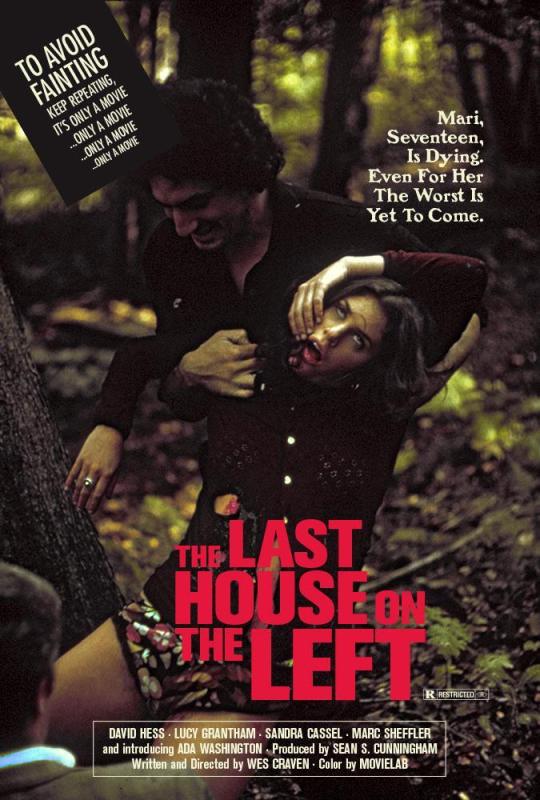
THE CRAZIES, 2010:
The Crazies, released in 2010 and directed by Breck Eisner is a remake of the 1973 film of the same name. After a toxic virus enters a small farming town, people must fight for survival as everyone around them turns to insanity. The remake closely follows the original with a more polished and modern take.
Check out the trailer for The Crazies here: https://www.youtube.com/watch?v=J7w9uWFIMBs

Horror movies are often remade for a variety of reasons. There’s always a new generation of horror movie fans that want to experience the same scares people had in earlier times. People love to see their favorite characters come back and cause more chaos. Horror remakes also bring in a lot of money. For example, one article states, “Hollywood seems obsessed with remaking extremely well-known properties that are well-known purely because of how near perfect they were the first time. When searching for the next blockbuster, Holly wood managers frequently produce remakes of previous movies. The underlying rationale is that remakes, just like sequels and best seller adaptations for which high returns and low risk have been demonstrated are extensions of existing brands that can be expected to offer high return rates that other movies while involving less risk,” (Journal of Cultural Economic, 2015). In other words, horror remakes will continue to bring in more money because people love to see their favorite movies remade. Check out this website for more information on why remakes of horror movies are constantly being made: https://stranglingbros.com/uncategorized/why-are-so-many-horror-movies-being-remade/
Check out more horror remake suggestions:
https://editorial.rottentomatoes.com/guide/the-25-best-horror-movie-remakes/
RESOURCES:
Bohnenkamp, Björn, et al. “When Does It Make Sense to Do It Again? An Empirical Investigation of Contingency Factors of Movie Remakes.” Journal of Cultural Economics, vol. 39, no. 1, 2015, pp. 15–41. JSTOR, http://www.jstor.org/stable/44289556.
1 note
·
View note
Text
Influences In Media
Zombies are by now a mainstay within horror/thriller content, being one of, if not the most popular creatures to come out of horror ever.
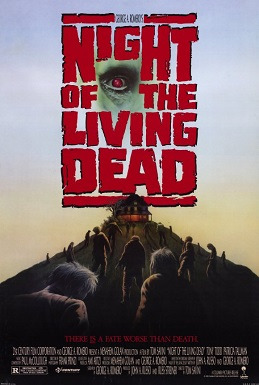
One of the earliest movies to depict zombies is the late George A. Romero’s ‘Night of The Living Dead’ the zombies in this depiction seem almost docile compared to modern interpretations and most people probably dismiss them as a non-threat, however, the classics zombies strengths become clear when they are in large hordes, in groups they can easily overwhelm you, on top of this, in most depictions of this type of zombies, when alone they can be surprisingly quiet and get a quick bite on you when least expected

The complete opposite of a classic zombie, we have the more modern, more feral zombies, these usually charge at you at insane speeds and attempt to rip you apart before you even realise what's happened, these zombies act less like the undead and more like a wild dog with rabies, they even clamber and climb over each other to get to their prey
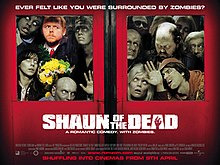
The final movie I want to mention is the more comedy centered ‘Shaun of The Dead’ this movie is probably one of my favourites as it takes something which is always depicted as bleak and sometime even bland and makes it comedic.
youtube
0 notes
Text
Once you watch a lot of pre-Walking Dead zombie media, you begin to understand that the Walking Dead is a fucking scam and Invincible is the story Robert Kirkman should be famous for.
0 notes
Quote
Sad to hear my favorite collaborator--and good old friend--George Romero has died. George, there will never be another like you.
Stephen King
49 notes
·
View notes